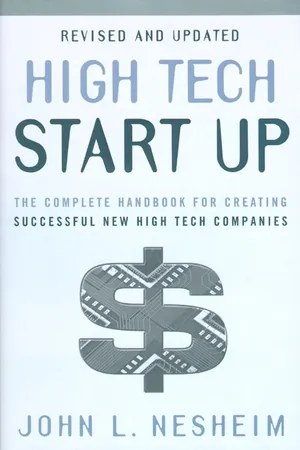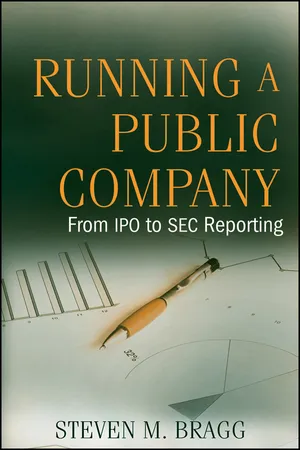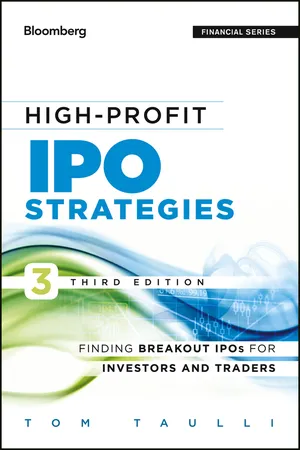Technology & Engineering
Initial Public Offering
An Initial Public Offering (IPO) is the process through which a private company offers shares of its stock to the public for the first time. This allows the company to raise capital from external investors and become publicly traded on a stock exchange. IPOs are often used by technology and engineering companies to fund expansion, research and development, and other strategic initiatives.
Written by Perlego with AI-assistance
Related key terms
Related key terms
1 of 4
Related key terms
1 of 3
9 Key excerpts on "Initial Public Offering"
- eBook - ePub
Investment Banking
Valuation, LBOs, M&A, and IPOs
- Joshua Rosenbaum, Joshua Pearl(Authors)
- 2020(Publication Date)
- Wiley(Publisher)
PART Four Initial Public OfferingsPassage contains an image
CHAPTER 8 Initial Public OfferingsAn Initial Public Offering (IPO) represents the first time a company (“issuer”) sells its stock to public investors. The shares are then traded on an exchange such as the Nasdaq Stock Market (Nasdaq), the New York Stock Exchange (NYSE), the London Stock Exchange (LSE), or the Stock Exchange of Hong Kong (SEHK). Collectively, these primary exchanges comprise what is commonly known as “the stock market”. Each publicly-traded company assumes a “ticker symbol”, typically a one-to-four-letter abbreviation that serves as a unique identifier. Once a company “goes public”, its shares will trade daily on the open market where buyers and sellers determine its prevailing equity value in real time.An IPO is a transformational event for a company, its owners, and employees. In many ways, the company and the way it operates will never be the same again. Detailed business and financial information will be made public and subject to analysis. Management will conduct quarterly earnings calls and field questions from sell-side research analysts. They will also speak regularly with existing and potential new investors. New accounting, legal, regulatory, and investor relations infrastructure and employees will need to be brought on board to handle public company requirements.While IPO candidates vary broadly in terms of sector, size, and financial profile, they need to feature performance and growth attributes that public investors would find compelling. Is the company and its addressable market large enough to warrant attention? Is it a market leader? How exciting is the growth opportunity? Is the cycle entry point attractive? How capable is the management team?Market conditions must also be conducive. The number of IPO offerings over a given time period is strongly correlated to the performance of the overall stock market. The better the market, the more plentiful the IPO pipeline. Similarly, in a down market, the IPO spigot slows to a trickle or may shut off entirely. Even a highly compelling candidate would most likely choose to wait rather than launch in an unfavorable market and risk an unsuccessful deal. - eBook - ePub
High Tech Start Up, Revised And Updated
The Complete Handbook For Creating Successful New High Tech Companies
- John L. Nesheim(Author)
- 2000(Publication Date)
- Free Press(Publisher)
13
Wall Street and the Initial Public OfferingW hen it’s time for your Initial Public Offering, you—the successful entrepreneur who has made it through all stages of start-up funding and of getting your product to market—must now look to Wall Street. In this chapter we will look at how investment bankers are ranked for high-tech companies, their role in the IPO, what and who motivates them, and how rich they can get from an IPO. You will learn how to choose the best investment banker for your company.The IPO is explained in detail, particularly how to time it, how to conform to securities laws, and how to price it, including how to apply some financial technology. We’ll also look at the question, “What should we do after the IPO?”The chapter includes lessons from the IPO trenches, specifically from details about the actual Microsoft IPO. Microsoft faced all the key issues that a start-up’s CEO and CFO must deal with at IPO time.New Issues and IPOs
“New issue” is the term applied to the first offering of stock of a new company, while IPO stands for “Initial Public Offering.” They are two terms from the jargon used in the special investment world that high-tech industry observers talk about so often. This world is filled with glamour, glory, and a great deal of work for participants, who plan to make a ton of money when the IPO is completed.This is the stage at which investment bankers enter the world of the start-up. The investment banker is in charge of the process that results in a single transaction that causes a flurry of activity in a start-up. The most significant change for the CEO and the start-up is being in the public limelight. Now the media are interested in the company and its leadership, and they request many time-consuming interviews, which takes up the time of the CEO and his or her staff. - David R Williams(Author)
- 2013(Publication Date)
- Woodhead Publishing(Publisher)
7The Initial Public Offering
Abstract:
This chapter examines the Initial Public Offerings in the biopharmaceutical market sector. It focuses on U.S. firms that have gone public and offers insight into other markets. After giving a brief history of stock exchanges, it looks at the process of selling securities on a public exchange for the first time. It examines the role that underwriters (investment banks) play in bringing a security to market. The chapter looks at the costs of becoming a publicly traded firm and shows trends in this market and the effect of an IPO on the firm and its management. The chapter also examines the financial condition of firms that have gone public and historical trends related to stock price and net proceeds.Key words Initial Public Offering research and development expenditures underwriting IPO process IPO costs7.1 An introduction to the Initial Public Offering
The term Initial Public Offering (or IPO) refers to the process by which a firm sells its stock for the first time on an open, public market. A public market is a place or system that allows for the exchange of a firm’s stock between individuals and entities. Examples of public markets or stock exchanges include the New York Stock Exchange (NYSE), NASDAQ, and the American Stock Exchange in the U.S., the London Stock Exchange in the United Kingdom, and Japan’s Tokyo Stock Exchange. Stock exchanges can be actual physical locations or virtual, on-line entities. Stock exchanges or markets allow individuals and entities the greatest opportunity to invest in other organizations.The reasons for firms to sell their stock on an open exchange include survival, growth, and exit1 –3- eBook - ePub
Running a Public Company
From IPO to SEC Reporting
- Steven M. Bragg(Author)
- 2009(Publication Date)
- Wiley(Publisher)
PART IHow to Go PublicPassage contains an image
CHAPTER 1The Initial Public OfferingIntroduction
The Initial Public Offering (IPO) is considered by many business owners to be the true sign of success—they have grown a business to the point where its revenue volume and profitability are large enough to warrant public ownership. However, the road to an IPO is both expensive and time consuming and requires significant changes to a company. This chapter describes the pluses and minuses of being public, as well as the steps required and costs to be incurred in order to achieve that goal.Reasons to Go Public
Though a management team may not say it, a major reason for going public is certainly to create a market for the shares they already own. Though these shares may not be available for sale for some time after the IPO, management will eventually be able to cash in its shares and options, potentially generating considerable profits from doing so. This reason is not publicized to the public, since the public would be less likely to invest if investors think the management team is simply cashing in and then leaving the business.A slight variation on the wealth creation theme is that, by having a broad public market for their shares, original shareholders are likely to see a rise in the value of their shares, even if they have no intention of selling the shares. The reason is that there is no longer a penalty for not having a ready market for the shares, which adds a premium to what the shares would have been worth if the company had remained privately held.The same logic can be used as a tool for employee retention. A private company can issue options to its employees, but they are worth little to the employees unless there is a market in which they can sell the shares. By going public, a company may experience increased employee retention, since they wish to wait until their options vest so they can cash in the resulting shares for a profit. - eBook - ePub
An Introduction to Molecular Biotechnology
Fundamentals, Methods and Applications
- Michael Wink, Michael Wink(Authors)
- 2013(Publication Date)
- Wiley-Blackwell(Publisher)
exit driven. No equity investor is interested in making profits from the dividend that a company pays to him as a shareholder. This means that the venture capital investor will evaluate at each and every stage whether they either have to put more money into the company or whether they are able to realize the value gain by selling their shares. There are only two ways this can occur:- An Initial Public Offering (IPO).
- A trade sale to another company.
The IPO is by far the preferred exit route for venture capital investors. In the process of the IPO, a company offers newly issued shares to institutional investors under the guidance and supervision of so-called underwriting banks. The underwriters ensure that the IPO prospectus is set up properly, describing the assets of the company, the future goals, and the basis for the current valuation of the issuing company. Institutional investors are those that have dedicated industry expert groups for such biotech investments. Their analysts evaluate the issuing company by certain financial measures; however, since nearly all biotech candidates are loss making, the evaluation of the technology or product basis is much more important. They compare the candidate with similar companies in peer-group comparisons.Institutional investors usually command huge funds that come from money that private people contribute from life insurance or other forms of investments. Classical pension funds are by far the biggest, but they only allocate a small percentage of their money in such high-risk investments.The key management of the company accompanied by industry experts of the underwriting bank(s) undertakes a road show from funds manager to funds manager in order to convince them to sign up for the issued shares. The orders of these funds managers are collected in the order book, literally a handwritten compilation of the individual share orders. At the end of the road show, during the book-building phase, the underwriters analyze the sensitivity of the potential stock price against the order demand. What they think the optimum is then becomes the issue price - eBook - ePub
High-Profit IPO Strategies
Finding Breakout IPOs for Investors and Traders
- Tom Taulli(Author)
- 2012(Publication Date)
- Bloomberg Press(Publisher)
Crowd funding . In 2012, the U.S. government passed legislation that made crowd funding legal. Essentially, this allows small companies to issue shares using the Internet. But keep in mind that these investments will likely not reach the IPO market for many years, if ever. In Chapter 22, we’ll take a closer look at crowd funding.Conclusion
While it may seem tempting to get IPO shares for the opening day, it can be risky. Even Facebook fell over 20 percent within a few days of its offering. A better approach—at least for long-term investors—is to wait a quarter or two before jumping in. The hype will subside and the stock will get seasoned in the market.Passage contains an image
Chapter 2
IPO Basics
It’s a common misconception that Initial Public Offerings (IPOs) are a guaranteed road to riches. Although there are many IPOs that do extremely well—like Google, NetSuite, Salesforce.com , Starbucks, and Chipotle—the fact is that IPOs are like any other investment: there is always risk. Before considering IPO investment strategies, it’s important for investors to understand what IPOs are and how they work.Anyone reading this book probably knows that an Initial Public Offering is the first sale of stock by a company to the public. It’s when a company makes the transformation from being privately held to becoming publicly traded, complete with its own ticker symbol. However, there’s probably a lot of other, more advanced IPO terminology that most people don’t know. For example: What does it mean when an IPO goes “effective”? What is the registration statement? What is the “red herring”? What exactly do the underwriters do? These questions—plus a great deal more about investing in IPOs—are covered in this book.This chapter takes a look at what motivates a company to launch an Initial Public Offering as well as a look at the drawbacks. We will also meet the major players in the IPO process.Why Do Companies Go Public?
There is no single answer to that question. It’s a major decision that will surely change the character of a company and mean many sleepless nights for management. What’s more, an IPO is very expensive. The company will need to hire attorneys, accountants, printers, and many other advisers described later in this chapter. - eBook - ePub
- J.K. Petersen(Author)
- 2018(Publication Date)
- CRC Press(Publisher)
. A Securities Commission government-regulated mechanism for a company to offer a variety of types of shares (usually common and preferred stock) to the general public. There are a number of categories of public offerings, both state and federal, with levels of restrictions and guidelines depending upon the amount of investment sought. Telecommunications and biotech are two of the hot areas of recent years, and some high-profile stock offerings have been carried out in the technology industry, one of the most visible being Netscape Communications, developers of Web browsers/servers and other applications.The investment for a company to go public can be considerable. Being listed on one of the large trading boards can cost millions of dollars. As a result, a number of Internet trading startups have been developing as an option for companies to make the availability and value of their shares known to the public.There are many companies that offer public shares that are not listed on the big boards; many are described on “pink sheets,” an information vehicle known to brokers, but not widely known to the public. This is because of very strict regulations against advertising stocks. It is permissible to provide information to investors who request it, but not to publicly promote company shares. These regulations are somewhat less stringent at the local level, with small offerings of a $million or half $million state-regulated Direct Public Offerings (DPO) providing some means for offering investor relations information to the public.DPOs were not widely known or attempted prior to the development of the Internet, because small companies making small stock offerings simply did not have the resources to provide investor information to potential investors and brokers in sufficient quantity to attract investment. Now that the Securities Commission has opened a few doors to stimulate investment in small companies, extremely important to the national economy, trading boards on the Internet are getting a lot of interest from investors and brokers, and DPOs are feasible for raising capital for seed and startup companies. - eBook - ePub
Initial Public Offerings
The mechanics and performance of IPOs
- Arif Khurshed(Author)
- 2011(Publication Date)
- Harriman House(Publisher)
Chapter 3: Mechanics of IPOs
In this chapter I discuss the mechanics of an IPO. I start with a look at different methods of flotation that are available to UK IPOs and then provide the timetable of an IPO. I also provide a discussion of how underwriters price IPOs by using an example of a hypothetical firm – this is an interesting area and one where not much has been published. The later sections of the chapter discuss how IPO shares are applied for, how IPO shares are allocated and how IPO shares are traded.3.1 Methods of flotation
[36]In the UK, a firm planning a listing can choose different methods of conducting an IPO. These methods have different implications both for potential investors and the firms themselves. The two main methods of going public are:- Public offer
- Placing
Within public offers, there are a number of variations:1. A public offer
In a public offer, the underwriter offers the company’s shares to private and/or institutional investors (for example, pension funds and insurance companies) and normally arranges for the offer to be sub-underwritten by a syndicate. A public offer could be domestic or global. A public offer usually comes with an explicit guarantee from the underwriter that if any shares remain unsold (after the close of applications), the underwriter will buy them from the IPO company.- In an offer for sale (the most commonly used public contract in recent years) the sponsor offers shares at a fixed price to individual and institutional investors. For example, in the largest IPO on the Main Market of the the LSE for the year 2008, Fresnillo Plc chose to use a global public offer. It priced its shares at 555p per share and invited subscriptions from investors from a large number of countries around the world.
- In an offer for sale by tender
- Charlie Karlsson, Börje Johansson, Roger Stough, Charlie Karlsson, Börje Johansson, Roger Stough(Authors)
- 2013(Publication Date)
- Routledge(Publisher)
Forming a currency of stock for future M&A deals is actually one of the most important motivations for going public (Bonardo et al., 2010). Second, the IPO may also mitigate inefficiencies in the M&A market in another way. IPOs can be part of a larger process of transferring control rights, where owner-managers of private firms use the IPO as part of a divestiture strategy. In order to identify potential acquirers and to increase a firm's visibility, shareholders of private firms could decide to use sequential divestitures through IPOs rather than outright sales. The process of going public would therefore be responsive to adverse selection problems by increasing the amount of information available on the firm (Reuer and Shen, 2003). The IPO and the contextual move from the private to the public domain increases the level of a firm's disclosure and of investors' monitoring. The consequent decrease in information asymmetries may, in turn, increase the opportunities of equity deals. To the extent that the process of going public credibly reveals information on a firm's value, the IPO market can enhance the efficiency of the M&A market. Such a certification role in the process of going public is typically played by investment bankers involved in the IPO pricing. They are expected to credibly certify the quality of firms because of the repeated nature of their business, which encourages them to preserve their reputational capital and to desist from opportunism (Paleari et al., 2008)
Index pages curate the most relevant extracts from our library of academic textbooks. They’ve been created using an in-house natural language model (NLM), each adding context and meaning to key research topics.
Explore more topic indexes
Explore more topic indexes
1 of 6
Explore more topic indexes
1 of 4








